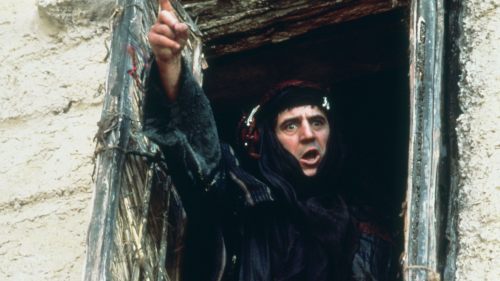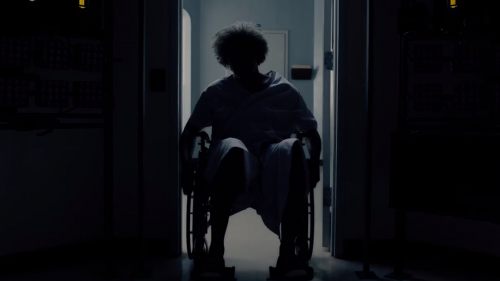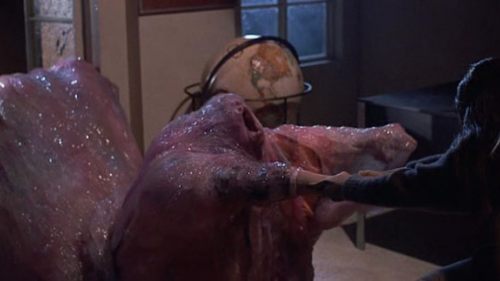Sunday Reads: Grappling With MONTY PYTHON’S THE MEANING OF LIFE 35 Years On
The end of Monty Python’s Flying Circus was a mercy killing. While 1974’s truncated fourth season continued to experiment with long-form comedic narrative, its blunted satire and desperate raucousness only served to prove John Cleese’s contention that the show was becoming stale and derivative, even of itself: the third season was his last.
However, unlike other break-ups of popular British entertainment groups, this wasn’t the end of Monty Python: the troupe’s second film, Monty Python and the Holy Grail, filmed in between the third and fourth seasons of Flying Circus, was released the following year and the six Pythons continued their personal and working relationships while also performing live stage shows and releasing audio recordings under the Monty Python banner. The success of Holy Grail led to a second narrative feature, 1979’s Monty Python’s Life Of Brian, but when a unifying storyline failed to emerge from the writing sessions for a fourth film the team returned to what they knew best, hanging the material around a loose theme to form 1983’s Monty Python’s The Meaning Of Life.
The Meaning Of Life refuses to take the easy option of simply revisiting familiar Flying Circus characters and setups: the Gumbys, “It’s” Man, Nude Organist, Knight With A Raw Chicken. Studio panels are nowhere to be seen, and not once is the next sketch introduced as something completely different. Instead there are less self-consciously surreal or shocking characterisations and situations, a reflection of the film’s confidence in performances and concepts made all the more effective by being anchored in realism.
However, familiar Python themes are still at play. The distrust of organised religion which informs both Life Of Brian and the lampooning of the Spanish Inquisition is central to Part I’s Birth In The Third World sequence, while the railing against dehumanisation brought about by institutionalised society and industry seen in sketches skewering overly-serious colonels, boring financiers and upper class twits anchors Parts II and III. The portrayal of the lower classes as uneducated grotesques enduring banal existences depicted by the troupe affecting falsettos and women’s clothing – the so-called Pepperpots – runs through Parts IV and V before it’s used to peel away the thin veneer of Mr. Creosote’s fellow diners’ middle class in Part VI and becomes the Grim Reaper’s raw contempt for Part VII’s social climbers.
Many of the comedic devices also survive: mismatched concepts such as a blancmange playing tennis or a building weighing anchor; adults playing schoolchildren; bizarre behaviour ignored; adherence to social propriety in the face of transgression; sporting contests made one-sided by abusing power imbalances; breaking the fourth wall; out-of-place erudition, particularly in the form of philosophical discourse; domestic situations made horrific by mindless bureaucracy; gallows humour and good old-fashioned slapstick, all delivered with a level of sophistication that belies its simplicity.
Also simplified are the film’s transitions: Flying Circus aimed to avoid punchlines at the end of sketches, substituting non-sequiturs and post-modern meta-commentary, and while The Meaning Of Life sticks to this principle it relies on simple cuts and the portentous delivery of the title cards to elegantly achieve the same effect, neatly meshing with the film’s measured, confident tenor.
That tenor stems from the freedom the troupe gained with the end of Flying Circus to explore their individual interests and aspirations in various non-Python projects. Of these, the most successful is Fawlty Towers, minutely-observed farce resulting from John Cleese’s cerebral approach to the theory and practice of comedy, its central character an amalgam of Flying Circus’ neurotic Little Englanders. The songs, spoofs and language-based sketches which formed the backbone of Eric Idle’s repertoire are further refined in his Rutland Weekend Television and its Beatles-parody mockumentary spin-off All You Need Is Cash, while in The Odd Job yet another of Graham Chapman’s bewildered everymen is sucked into spiralling farce, similar to the characters he brought to US TV’s Saturday Night Live as he developed his pirate-with-a-tax-problem movie Yellowbeard. Michael Palin and Terry Jones’ writing partnership continued to develop narrative comedy using historical events as a jumping-off point with the boy’s own adventures of Ripping Yarns, Palin further exploring Edwardian sexual mores in The Missionary while Jones embarked on serious academic study of the Knight in Chaucer’s The Canterbury Tales, the same medieval period providing the setting for Terry Gilliam’s live action dark fable Jabberwocky before his world-spanning fantasy Time Bandits romped through history.
Many of these projects also involved not only other Pythons but also their amassed collaborators and admirers, further blurring the boundaries of the Pythonesque – that indefinable quality that distinguishes the troupe’s output – while also distilling its essence into the harder, darker The Meaning Of Life.
Not that the film is any less immediately recognisable as Monty Python, with its title sequence rendered in Gilliam’s distinctive animation and sets evocative of the TV show, all treated to the same quality upgrade as the costumes and special effects. However, Jones brings a new level of sophistication with his direction, unafraid to put his camera in the middle of the action and elaborate musical numbers, and the cast’s broader experience is evident in performances matching the restraint of a script which both plays to their strengths and subverts expectations.
While The Meaning Of Life uses its theme more as a linking device than the basis of a thesis, it nonetheless has a distinct viewpoint. Setting aside for a moment the downtrodden workers of The Crimson Permanent Assurance refusing to relinquish dreams of swashbuckling heroism in the face of rapacious conglomerates, the film’s seven parts, each tackling a different stage of life, allude to Shakespeare’s “All the world’s a stage” monologue but expand upon the nihilism evident throughout the Python oeuvre.
In The Miracle Of Birth, procreation is a joyless inconvenience, while Growth And Learning packs children off to boarding school to be inculcated with a fear of God and intimacy prior to being fed into the meat grinder of war in Fighting Each Other. The Middle Aged are unhappy despite their lack of intellectual curiosity and interior life while Live Organ Transplants finds nothing but futility in individual existence when set against the enormity of creation or the power of institutions, which neither pleasures of the flesh nor homespun wisdom can comfort in The Autumn Years. The only relief is to be found in Death – whether brought about by pursuing topless women, existential grief or the salmon mousse – and the awaiting afterlife of relentless Christmas cheer and consumerism with the players all gathered around that stage.
Which is not to say The Meaning Of Life argues for nihilism. In the accountants’ retreat into fantasy in The Crimson Permanent Assurance, the kinky Dadaism of Find The Fish, the upkeep of social graces in the trenches and the joy of song and dance there’s a simple plea to actively seek and celebrate one’s own meaning in life. It’s the same philosophy espoused in Life of Brian’s closing song, one that drives the Pythons’ repeated presentation of very human victims of an uncaring, even nonsensical existence. It’s a philosophy of humanism that survived the Pythons’ transition from young men railing at the Establishment to becoming the Establishment themselves as their influence penetrated every corner of comedy, one a dragged-up Michael Palin summarises at The End Of The Film as he opens an envelope to reveal The Meaning Of Life: “Try and be nice to people, avoid eating fat, read a good book every now and then, get some walking in, and try and live together in peace and harmony with people of all creeds and nations.”
While the collaborations continued and the troupe gave a series of farewell concerts entitled Monty Python Live (Mostly): One Down, Five to Go in 2014 (this writer attended the opening night, quoting and singing along with the other 16,005 people in London’s O2 Arena), it was The Meaning Of Life which effectively marked the end of Monty Python. That end is brought full circle in the film’s final, poignant shot: “The Liberty Bell” rings out once more as a '50s TV plays Monty Python’sFlying Circus, floating into space to find its own place and purpose in the firmament.



